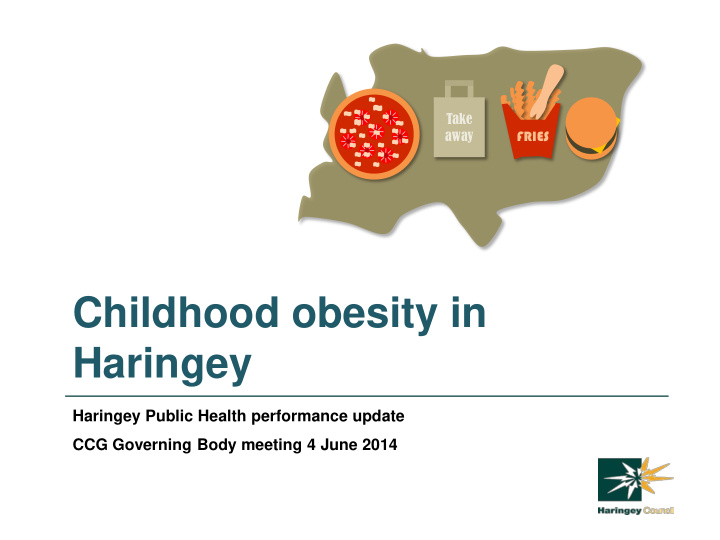



Take away FRIES Childhood obesity in Haringey Haringey Public Health performance update CCG Governing Body meeting 4 June 2014
Prevalence of childhood obesity In Haringey, a higher proportion of children are obese and overweight by year 6 than in reception year Nearly Over 1 in 4 1 in 3 children are overweight or obese children are overweight or obese in reception year in year 6 (2013) (2013) 2 Source: Public Health England
Trends Most recent trends show obesity Year 6 children and overweight in reception going % obese and overweight in Haringey 2013 down and rising in year 6 39% 40% % of children Reception children % obese and overweight in Haringey 2013 30% Haringey % of children London 23% England 20% 20% 2007 2008 2009 2010 2011 2012 2013 2007 2008 2009 2010 2011 2012 2013 3 Source: Public Health England
Differences by gender A higher proportion of boys are obese and overweight Obesity and overweight by gender % obese and overweight in Haringey 2013 50% Prevalence (%) 43% Reception 38% Year 6 25% 22% 0% Female Male 4 Source: Public Health England
Differences Obesity and overweight by ethnicity % obese and overweight in Haringey 2013 by ethnicity 0% 10% 20% 30% 40% 50% 60% 29% Black - Any Other Black 53% 20% Asian - Pakistani 50% Around half of some 22% Black - Black Caribbean 48% black and minority 35% Black - Black African 48% ethnic groups are 22% Asian - Bangladeshi 48% obese and 25% Mixed - Any Other Mixed 46% overweight by year 6 21% Mixed - White and Black Caribbean 44% compared to 1 in 5 26% White - Any Other White 43% white British children 29% Mixed - White and Black African 38% 15% Asian - Indian 34% 23% White - White Irish 31% Reception 11% Mixed - White and Asian 30% Year 6 16% White - White British 21% 20% Asian - Any Other Asian 20% 19% Chinese 7% 25% Any Other Ethnic Group 50% 23% Not known 52% 5 Source: Public Health England
Prevalence by ward Prevalence of overweight or obesity in year 6 by ward, 2013 Not all equal: more childhood obesity and overweight in the east, especially South Tottenham. 6 Source: London Borough of Haringey 6
Risk factors and social determinants Wider Early life influences: influences: Household poverty, maternal nutrition, low birthweight - newborn over feeding increase risk of obesity, role models, breast feeding Obesogenic environment and food industry influence Schools Local Household Culture and norms PE & after school circumstances: environment: of society activities/healthy Income, diet Access to green schools approach offered/afforded at spaces, density of Urban to healthy eating and home etc. fastfood outlets etc. environment & physical activity planning, access to green spaces Deprivation and social inequalities Energy imbalance Health policy 7 Source: Haringey JSNA, Childhood Obesity (2013)
Local research on fast food outlets around schools: Key findings + + Access & Affordability Acceptability availability £ = Obesity 8 Source: City University (2013) Children’s food choices on the streets around schools in Haringey: A wall of crisps and other food choices
Geographical spread of obesity and fast food outlets Percentage of year 6 children who are obese (2011) Concentration of outlets around schools. 9 Source: City University (2013) Children’s food choices on the streets around schools in Haringey: A wall of crisps and other food choices
Next steps Environmental Health • PH additional environmental health officer post - introducing the Healthier Catering Commitment (HCC) • Hygiene compliant businesses in Tottenham to attend training to learn more about the HCC Working with schools • Implementing the recommendations in the new School Food Plan • Share good practice through the Healthy Schools network • Utilise the evidence base to support commissioning around school food Planning A proposal for a 400m exclusion zone for fast food outlets around schools was consulted on in March 2013. This is being further considered in light of consultation responses and the growing body of evidence 10
Impact of childhood obesity CVD • Illness and absence from school • Asthma Diabetes Increased • Health-related risk of limitations adult • Obstructive sleep Obesity apnoea Some (BMI >30) • Bullying cancers • by adolescence, be at increased risk of low Mental Long self-regard and health standing impaired quality of life High (inc. in obese individuals illness blood low self pressure esteem) Wijga et al, 2010; Egan et al 2013; Narang, Mathew, 2012 Source: Haringey JSNA, Childhood Obesity (2013) 11
Action plan To help tackle these issues we are working closely with early years settings and schools: Strongly promoting early intervention and prevention strategies through breastfeeding developments and the HENRY (Health Exercise Nutrition for the Really Young) programme, which helps families with very young children develop skills around healthy eating and leading an active lifestyle. Making every contact count – and ensuring that the Brief Intervention Training – Raising the Issue of Weight - is well attended by a variety of local professionals Strengthening our Healthy Schools Programme to help support schools in becoming natural hubs of health & wellbeing, including targeting evidence-based interventions in schools where they are most needed. 12
What can the CCG do about childhood obesity? The Governing Body are asked to: Ensure commissioning plans address the risks of child obesity and related disorders including diabetes Include maternal obesity within service specification for commissioning of maternity services Actively promote the brief intervention training for families, to enable GPs and other health professionals to raise the issue of weight and offer brief interventions, ensuring that every contact counts. Promote the forthcoming childhood obesity pathway 13
Recommend
More recommend